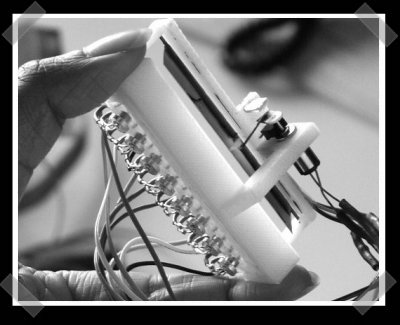
I found [Stefan]’s work through his older, but interesting TinyProjector project. He opted to use multiple diodes in various configurations with rotating mirrors to create images. He’s built quite a few interesting projects over the years. The WeatherTank is pretty sweet.
12 thoughts on “TinyProjector: Mini POV Laser Projector”
Leave a Reply to SPmanCancel reply
Please be kind and respectful to help make the comments section excellent. (Comment Policy)















Looks good, and it uses lasers! :O
Nice, i just made a similar project for school and i program it with a PLC. And i know that it takes a lot of work to build such a thing. Nicely done.
you have to love MIT’s media lab. i’m a big fan of their OLPC (One Laptop Per Child) project.
I was about to reply to the author, but then noticed the date…. so I’ll stick my reply here.
—
Hi,
Interesting little project….
Did you consider a spining multifaced mirror (rather than an osscilating flat one) this would be easier to drive and wouldn’t have the ‘flapping’ forces.
One thing to notice is that as the mirror surface is not on axis that angluar speed of the reflected light would not be constant – but this can be compensated if you can modulate the source light and time the pixels appropriately. If it seems that I know too much, it’s because we almost used a similar system but couldn’t modulate our source (UV Laser) appropriately.
Another idea (shee’s I’m full of them ;-) I had while typing is that you could introduction a secondary ‘spinner’ to do the vertical scanning from a signal point source (diode laser?).
This could be a 1 pitch screw with a 45′ face to it, spinning at 1/N th of horizontal scanner to give appropriate vertical resolution.
Did that make sense? do you want me to sketch to explain further?
Munge.
Munge
Sketch Please
Thats a nice project. Munge, I had some ideas of doing a similar project, but rather than having the two mirrors linked so one was going an exact multiple of the others speed to get a certain resoloution, I was going to use two independant motors, going at fairly different speeds, each of which had an optical sensor to detect rpm. That caused the “point” to randomly move around them image area, and if it was moving fast enough it would cover all areas. The circuitry could modulate the signal using the optical sensors to estimate the current position of the point, and then using a lookup table to find the right data in a pic. The benefit of using this design is a relatively high resoloution possible without getting “flickering” of progressive scanning, while avoiding the mechanical complexities of doing interlacing. The problems with the design are:
I didn’t have anything pic-like which had enough memory and a high enough clock frequency to make this effective for the sorts of resoloution I was looking for (300×300), especially since I wanted a moving image rather than a static one (so the pic also needs to read the data in from a data source, like usb, high speed serial, or some flash memory).
The total intensity of the laser is spread over the entie area of the “display” – that means it wouldn’t be visible in anything but the darkest of rooms, unless you used a more powerful laser diode, which start top get hard to get hold of.
you can get faster and easer results by intergradeing a different microcontroler like an avr or a arm
http://www.pactecenclosures.com/Plastic-Enclosures/T-Series.html
one of thease might work for a good handheld inclosure
inclosure = enclosure in english…
Why use a recipricating mirror when a spinning one would yeld less vibe?
Would potting the diodes help with the exposure issue?
How about using metalized plastic to save hieght and gain reflectivity?
I wish I had access to a 3D printer for my electronics projects.
Man you put some work here- respect. I can imagine these CAD drawings took some time.